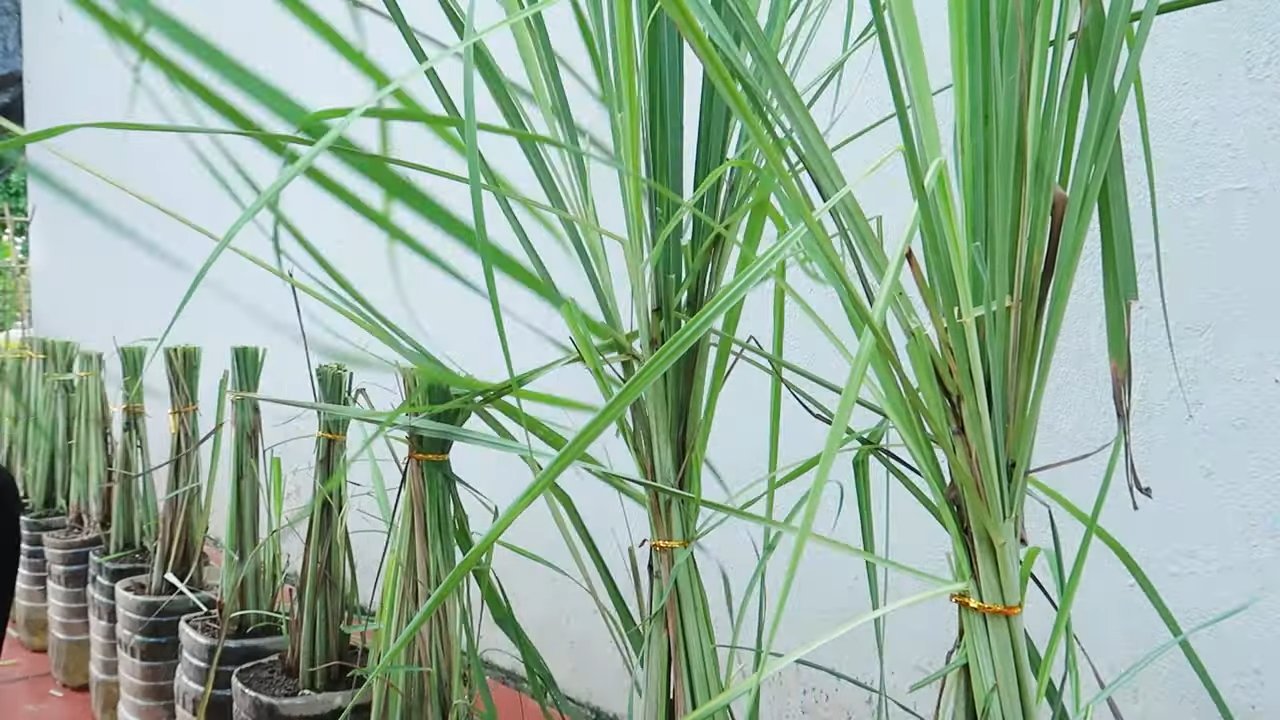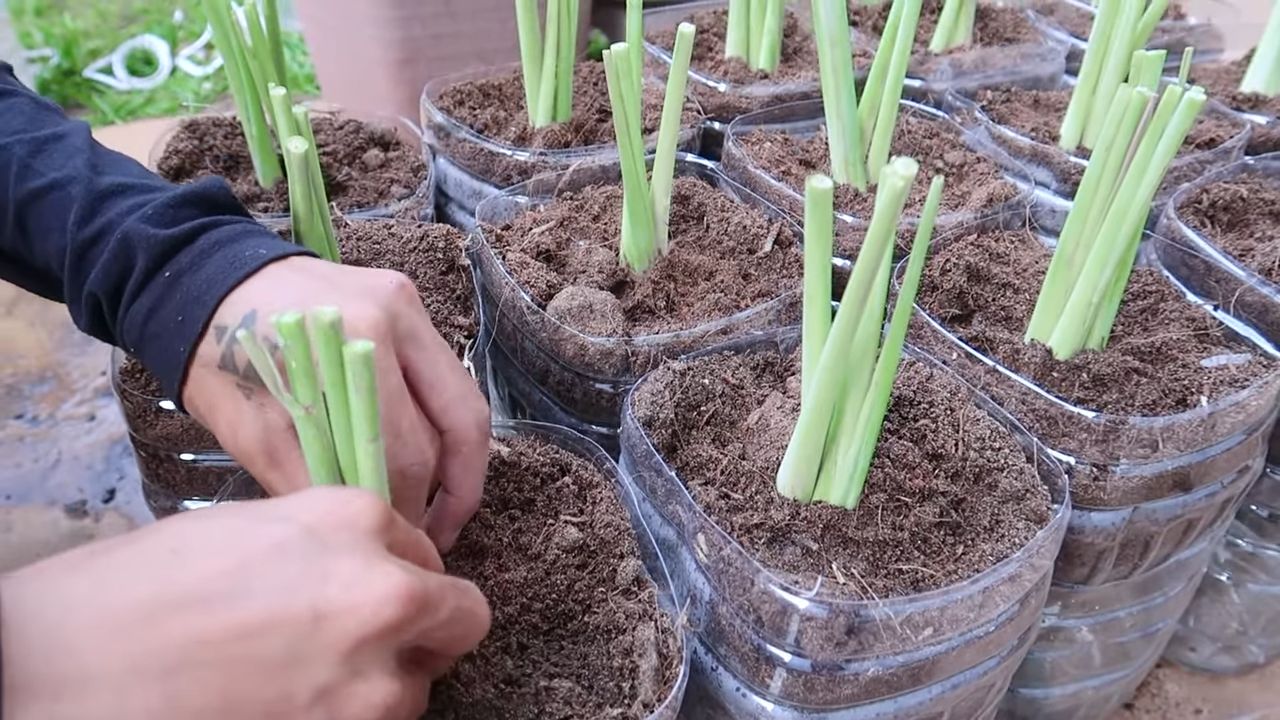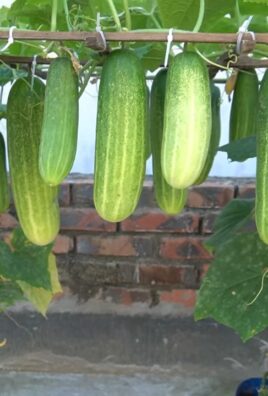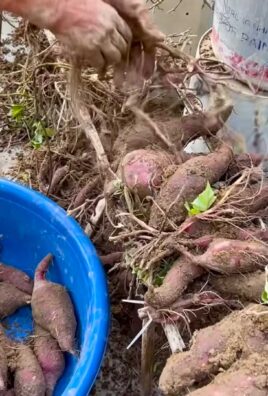Grow Lemongrass at Home: Imagine stepping into your backyard and snipping fresh, fragrant lemongrass for your favorite Thai curry or a soothing cup of tea. Sounds dreamy, right? Well, it doesn’t have to be just a dream! This DIY guide will unlock the secrets to successfully cultivating this versatile herb right in your own home, no matter your gardening experience.
Lemongrass, with its vibrant citrusy aroma, has been a staple in Asian cuisine and traditional medicine for centuries. Originating in Southeast Asia, it’s revered not only for its culinary uses but also for its potential health benefits, from aiding digestion to acting as a natural insect repellent. For generations, families have passed down knowledge on how to best nurture this plant, and now, I’m excited to share some of those time-tested tips with you.
Why should you learn to grow lemongrass at home? Simple! Store-bought lemongrass can be expensive and often lacks the freshness and potency of homegrown varieties. Plus, knowing exactly where your food comes from and how it’s grown is incredibly rewarding. Whether you have a sprawling garden or just a sunny windowsill, this guide will provide you with the easy-to-follow steps and clever hacks you need to enjoy a bountiful harvest of fresh lemongrass all year round. Let’s get started!

Growing Lemongrass at Home: A DIY Guide
Hello everyone! I love the fresh, citrusy aroma and taste of lemongrass. It’s not only a fantastic ingredient for Asian dishes but also a natural insect repellent and can be used for soothing teas. Instead of always buying it at the supermarket, I decided to grow it myself. And guess what? It’s easier than you think! Here is my detailed DIY guide on how to grow lemongrass at home, whether you have a garden, a balcony, or just a sunny windowsill.
What you need
Before we get started, make sure you have everything on hand. Here is a list of the things you will need:
- Lemongrass stalks: You can find them in most Asian supermarkets or sometimes in well-stocked grocery stores. Make sure the stalks look healthy and have a small root base.
- A glass or vase: To root the stalks.
- Water: Tap water is usually sufficient.
- A planter: Choose a pot with a diameter of at least 20 cm so the lemongrass has enough space to grow.
- High-quality potting soil: A well-draining potting soil is ideal. You can also add some compost to improve the nutrient supply.
- Optional: Liquid fertilizer: For an additional supply of nutrients during the growing season.
- Optional: Pruning shears or a knife: For trimming the roots and leaves.
Phase 1: Rooting the Lemongrass Stalks
The first step is crucial to ensure that your lemongrass grows well. We need to root the stalks first.
- Preparation of the stalks:
- Remove the outer, dry, or damaged leaves from the lemongrass stalks.
- Slightly trim the top ends of the stalks, about 2-3 cm. This helps to reduce evaporation and promote root formation.
- Soaking in water:
- Fill your glass or vase with about 5-7 cm of water.
- Place the lemongrass stalks in the water with the root base down. Make sure the root base is completely covered, but the leaves are not in the water.
- Placement and care:
- Place the glass in a bright, warm place, but avoid direct sunlight. A windowsill with indirect light is perfect.
- Change the water every 1-2 days to keep it fresh and clean. This prevents the formation of bacteria and promotes root growth.
- Patience is required:
- After about 1-2 weeks, you should see small roots forming at the base of the stalks.
- Let the roots continue to grow until they are about 5-7 cm long. This may take another 1-2 weeks.
Phase 2: Planting the Lemongrass
Once the roots are well-developed, it’s time to plant the lemongrass in a pot.
- Preparation of the planter:
- Make sure your planter has drainage holes so that excess water can run off.
- Fill the pot with high-quality potting soil. Leave about 2-3 cm of space to the rim of the pot.
- Planting the stalks:
- Dig a small hole in the center of the soil, large enough to accommodate the roots of the lemongrass.
- Carefully take a lemongrass stalk out of the water and place it in the hole. Be careful not to damage the roots.
- Fill the hole with soil and press it down lightly to stabilize the stalk.
- Repeat the process for the remaining stalks. You can plant several stalks in one pot, but make sure they have enough space to grow.
- Watering:
- Water the lemongrass thoroughly after planting. The soil should be moist, but not soggy.
- Placement:
- Place the pot in a sunny location. Lemongrass loves the sun and needs at least 6 hours of direct sunlight per day to grow optimally.
Phase 3: Caring for the Lemongrass
Proper care is essential for your lemongrass to grow healthy and strong.
- Watering:
- Lemongrass needs regular watering, especially during the growing season (spring and summer).
- Water when the top layer of soil feels dry.
- Avoid waterlogging, as this can lead to root rot.
- In winter, when growth is slower, reduce watering.
- Fertilizing:
- Fertilize your lemongrass every 2-4 weeks with a liquid fertilizer for herbs or vegetables.
- Follow the instructions on the fertilizer package.
- You can also use organic fertilizer such as compost tea.
- Pruning:
- Regularly cut off the dry or brown leaves to promote growth and improve the appearance of the plant.
- You can also trim the top ends of the leaves to keep the plant more compact.
- Overwintering:
- If you live in a region with cold winters, you need to bring your lemongrass indoors before the first frost.
- Place it in a bright, cool place and reduce watering.
- You can also put it into a dormant state by placing it in a dark, cool place and watering it very little.
- In the spring, when temperatures rise, you can put it back outside and increase watering and fertilizing.
- Pests and diseases:
- Lemongrass is relatively resistant to pests and diseases.
- However, watch for signs of aphids, spider mites, or root rot.
- In case of an infestation, you can use natural insecticides such as neem oil.
- To avoid root rot, ensure good drainage and avoid waterlogging.
Phase 4: Harvesting the Lemongrass
Harvesting the lemongrass is the most rewarding part!
- When to harvest:
- You can harvest your lemongrass as soon as the stalks have reached a diameter of about 1 cm.
- This is usually the case after about 3-4 months.
- How to harvest:
- Use sharp pruning shears or a knife to cut the stalks at the base.
- Cut the stalks as close to the ground as possible to encourage the growth of new shoots.
- Use:
- You can use the stalks fresh or dry them for later use.
- Lemongrass is a versatile ingredient that can be used in many different dishes, such as soups, curries, teas, and marinades.
- You can also use the leaves to make tea or use them as a natural insect repellent.
Additional Tips and Tricks
Propagation: You can also propagate your lemongrass by division.

Conclusion
So, there you have it! Growing lemongrass at home is not only achievable, but it’s also incredibly rewarding. Imagine stepping into your kitchen and having fresh, fragrant lemongrass readily available for all your culinary adventures. No more last-minute trips to the grocery store or settling for dried substitutes that lack the vibrant zest of the real deal. This simple DIY trick transforms your kitchen into a haven for fresh herbs, and your cooking will never be the same.
But the benefits extend beyond just convenience. Think about the satisfaction of nurturing a plant from a simple stalk to a thriving bush. It’s a connection to nature, a small act of self-sufficiency, and a beautiful addition to your home, whether you choose to keep it indoors or out. Plus, you’ll be reducing your carbon footprint by avoiding commercially grown and transported lemongrass.
Why is this a must-try? Because it’s easy, cost-effective, and delivers unparalleled flavor. You’re essentially getting a continuous supply of fresh lemongrass for the price of a single stalk. It’s a win-win situation!
Ready to experiment? Consider these variations:
* Container Gardening: If you’re short on space, lemongrass thrives in pots. Choose a large container with good drainage and use a well-draining potting mix. This is perfect for balconies, patios, or even sunny windowsills.
* Different Varieties: While most lemongrass sold in grocery stores is the common variety, there are other types you might want to explore. Look for ‘Cymbopogon citratus’ for culinary use.
* Companion Planting: Lemongrass is a great companion plant for vegetables like tomatoes, peppers, and cabbage. Its strong scent can help deter pests.
* Lemongrass Tea: Don’t forget the health benefits! Fresh lemongrass makes a delicious and soothing tea. Simply steep a few chopped stalks in hot water for a refreshing beverage.
* Lemongrass Oil: You can even try making your own lemongrass-infused oil for cooking or aromatherapy.
We’re confident that you’ll be amazed at how easy it is to grow lemongrass at home. It’s a project that’s both fun and practical, and the results are incredibly satisfying.
Now, it’s your turn! Give this DIY trick a try and share your experience with us. We’d love to see your lemongrass thriving! Post pictures of your progress, share your tips, and let us know how you’re using your homegrown lemongrass in your favorite recipes. Let’s create a community of lemongrass growers and inspire others to bring fresh flavor into their homes. Don’t hesitate to ask questions or share any challenges you encounter – we’re here to help! Happy growing!
Frequently Asked Questions (FAQ)
1. What kind of lemongrass should I buy to propagate?
You’ll want to purchase fresh lemongrass stalks from your local grocery store or Asian market. Look for stalks that are firm, green, and have a bulbous base with some root nubs. Avoid stalks that are dry, brown, or look like they’ve been sitting for a long time. The fresher the stalk, the better your chances of successful propagation. Organic lemongrass is always a great option if available.
2. How long does it take for lemongrass to root?
Generally, you should start to see roots emerging from the base of the lemongrass stalk within 1-3 weeks. The warmer the environment and the more sunlight it receives (indirect sunlight is best), the faster it will root. Be patient, and make sure to change the water every few days to keep it fresh and prevent bacterial growth. If you don’t see any roots after three weeks, it might be worth trying a different stalk.
3. What kind of soil is best for planting lemongrass?
Lemongrass thrives in well-draining soil that is rich in organic matter. A good potting mix specifically designed for herbs or vegetables will work well. You can also amend your garden soil with compost or well-rotted manure to improve its drainage and fertility. The ideal pH for lemongrass is between 6.0 and 7.0.
4. How much sunlight does lemongrass need?
Lemongrass needs at least 6 hours of direct sunlight per day to thrive. If you’re growing it indoors, place it near a sunny window that receives plenty of light. If you’re growing it outdoors, choose a location that gets full sun. However, in very hot climates, some afternoon shade can be beneficial to prevent the leaves from scorching.
5. How often should I water lemongrass?
Water lemongrass regularly, especially during hot and dry weather. The soil should be kept consistently moist, but not waterlogged. Check the soil moisture by sticking your finger into the soil – if it feels dry an inch or two below the surface, it’s time to water. Reduce watering during the winter months when the plant is not actively growing.
6. How do I harvest lemongrass?
To harvest lemongrass, simply cut off the stalks near the base of the plant. Use a sharp knife or pruning shears to make a clean cut. You can harvest individual stalks as needed, or you can harvest the entire plant at once. The lower, thicker portion of the stalk is the most flavorful and is typically used in cooking.
7. Can I grow lemongrass indoors year-round?
Yes, you can grow lemongrass indoors year-round, especially if you live in a climate with cold winters. Provide it with plenty of sunlight, water it regularly, and fertilize it occasionally. You may need to supplement with artificial light during the winter months to ensure it gets enough light.
8. How do I fertilize lemongrass?
Fertilize lemongrass every 2-3 weeks during the growing season (spring and summer) with a balanced liquid fertilizer. Follow the instructions on the fertilizer label. You can also use a slow-release fertilizer at the beginning of the growing season. Avoid over-fertilizing, as this can lead to leggy growth.
9. Is lemongrass susceptible to any pests or diseases?
Lemongrass is generally resistant to pests and diseases. However, it can occasionally be affected by aphids, spider mites, or fungal diseases. If you notice any pests or diseases, treat them promptly with an appropriate insecticide or fungicide. Good air circulation and proper watering can help prevent these problems.
10. How do I overwinter lemongrass in cold climates?
If you live in a climate with cold winters, you’ll need to protect your lemongrass from frost. You can either bring it indoors and grow it as a houseplant, or you can mulch it heavily with straw or leaves to insulate the roots. If you choose to mulch it, cut back the foliage to a few inches above the ground before applying the mulch. In very cold climates, it’s best to dig up the plant and store it in a cool, dark place until spring.
11. Can I propagate lemongrass from seed?
While it’s possible to propagate lemongrass from seed, it’s much easier and faster to propagate it from stalks. Lemongrass seeds can be difficult to germinate, and the resulting plants may not be as vigorous as those grown from stalks.
12. What are some common uses for lemongrass?
Lemongrass is a versatile herb that can be used in a variety of dishes. It’s commonly used in Southeast Asian cuisine, particularly in soups, curries, and stir-fries. It can also be used to make tea, infused oils, and essential oils. Lemongrass has a refreshing citrusy flavor with a hint of ginger.
13. My lemongrass is turning brown. What am I doing wrong?
Browning leaves on lemongrass can be caused by several factors, including underwatering, overwatering, lack of sunlight, or nutrient deficiencies. Check the soil moisture and adjust your watering accordingly. Make sure the plant is getting enough sunlight. If the problem persists, try fertilizing it with a balanced fertilizer.
14. How big will my lemongrass plant get?
Lemongrass can grow quite large, reaching a height of 3-5 feet and a width of 2-3 feet. If you’re growing it in a container, choose a large pot to accommodate its growth. You can also prune it regularly to keep it at a manageable size.
15. Is lemongrass safe for pets?
While lemongrass is generally considered safe for pets, it’s best to keep them from eating large quantities of it. Some pets may experience mild gastrointestinal upset if they ingest too much lemongrass. If you’re concerned about your pet eating lemongrass, keep the plant out of their reach.




Leave a Comment